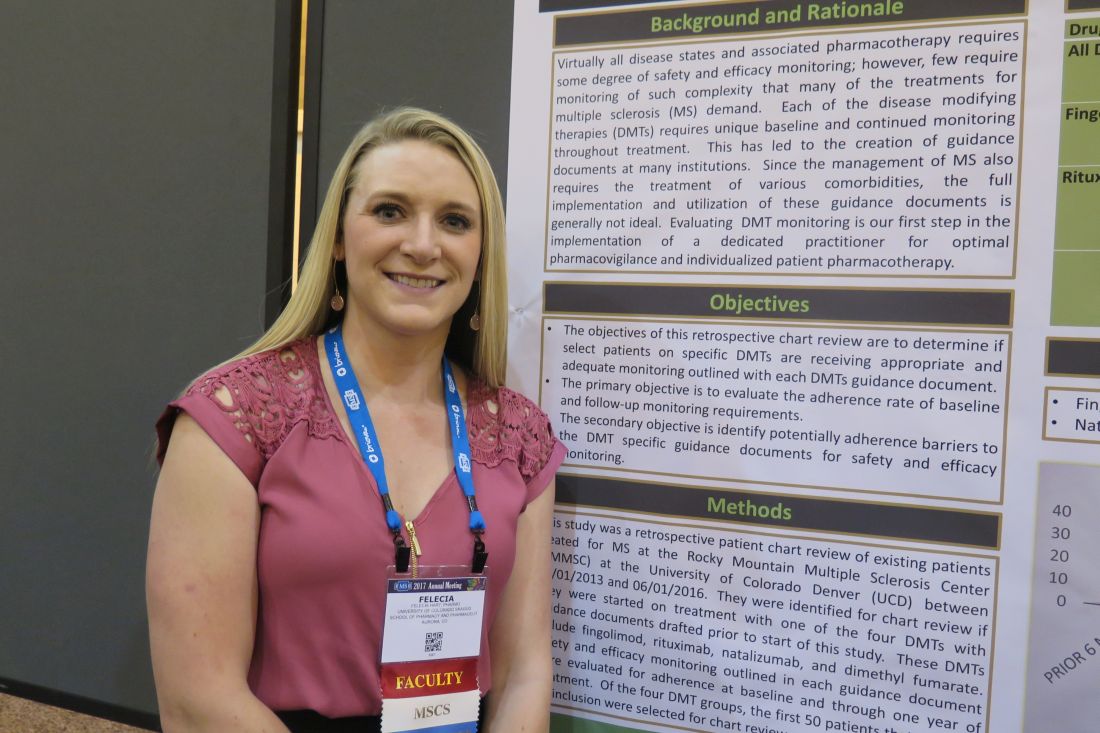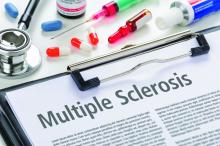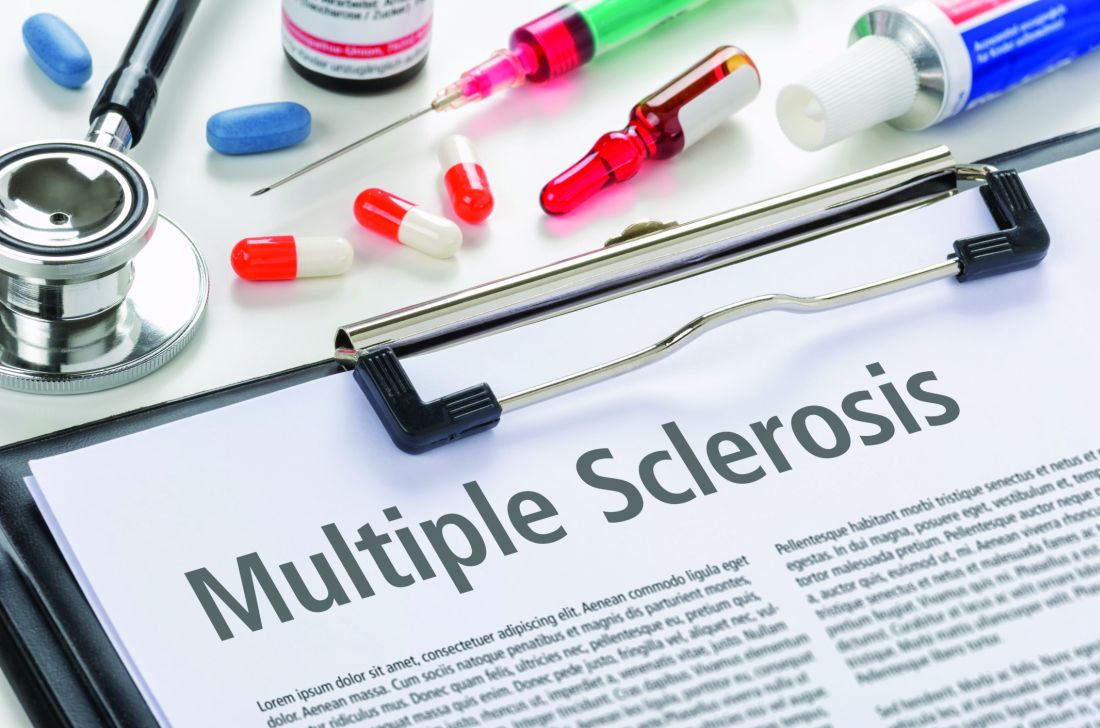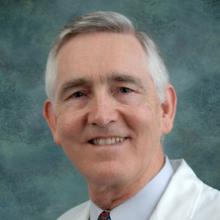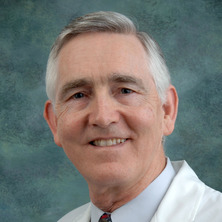User login
Multiple Sclerosis Hub
Revisions coming to McDonald Criteria for MS
NEW ORLEANS – Changes are coming to the current McDonald Criteria for diagnosing multiple sclerosis, primarily because of advances in the understanding of MS since the criteria were last updated in 2010.
Such advances include the availability of new data regarding the relationship between MS and other spectrum disorders and data concerning the performance of the 2010 McDonald Criteria in several patient populations, according to Jeffrey A. Cohen, MD, who cochaired the effort known as the International Panel on Diagnosis of Multiple Sclerosis. “There also were new data concerning the utility of cerebrospinal fluid evaluation and increasing recognition that the role of cerebrospinal fluid (CSF) examination perhaps needs increased emphasis,” Dr. Cohen said at the annual meeting of the Consortium of Multiple Sclerosis Centers. “It’s been somewhat de-emphasized in previous versions of the criteria. Then, there was identification of subsets of patients that were felt to have a high likelihood of MS but in whom the diagnosis could not be made by the current criteria – patients who fell through the cracks. There was also increasing recognition of the frequency and important consequences of misdiagnosis.”
The panel emphasized that evidence supporting the McDonald criteria is predominately based on patients with a typical clinically isolated syndrome (CIS) at onset. It also acknowledged the difficulty of confirming a diagnosis of MS, the importance of addressing alternative diagnoses and absence of atypical features and red flags, and the rigor necessary for interpreting clinical, imaging, and laboratory studies. “Misdiagnosis is common,” Dr. Cohen told meeting attendees. “In some series, upwards of 50%-60% of patients referred to a specialized MS center turn out to have some other diagnosis. Our panel had discussions related to the tradeoff between sensitivity of the criteria and trying to make the diagnosis earlier and in a broader range of patients but counterbalancing that against the risk of a misdiagnosis. Our conclusion was that, although some of that might be created by the criteria, it’s mostly a problem of misapplying the criteria. One needs to remember that to make the diagnosis of MS does not merely require demonstrating that the patient has a disease process that involves potentially multiple places in the CNS and as recurrent events over time, but one has to apply the diagnostic data with rigor.”
Another emphasis expected to be included in updated McDonald criteria is the use of CSF and spinal cord imaging, as well as the notion that a history, examination, and synthesis of a patient’s overall clinical picture “needs to be made by a clinician with MS-related expertise,” Dr. Cohen said. “One cannot merely use the criteria as a checklist.”
The panelists also discussed modifying the term “possible MS,” which is already in the McDonald criteria, to include patients with CIS who do not (yet) fulfill the diagnostic criteria for MS; radiologically isolated syndrome (RIS); solitary sclerosis; and patients with clinical manifestations, imaging, and other features that are compatible with MS but not typical for those who may or may not be determined to have MS or in the future.
Dr. Cohen noted that additional data concerning the applicability of the McDonald criteria to Asian and Latin populations have been published since 2010 but are modest. “There is no indication the McDonald criteria cannot be used in these populations,” he said. “Care is needed to address alternative diagnoses, particularly neuromyelitis optica spectrum disorder (NMOSD) in both and also infectious diseases in Latin America.” Several studies also support the applicability of the McDonald criteria in children, with certain caveats. “One needs to be careful in diagnosing MS in people younger than 11 years of age,” Dr. Cohen said. “If the initial event is [acute disseminated encephalomyelitis], they also need to have a typical clinically isolated syndrome.”
Panelists also agreed that the McDonald criteria apply to older patients, with caveats that a new diagnosis of MS is rarely considered in older adults. “They are more likely to have a progressive course, either progressive from onset or following previous unrecognized relapses,” Dr. Cohen said. “There needs to be careful consideration of alternative diagnoses and, particularly, comorbidities. This represents an example of a diagnostic scenario for which CSF examination is advised.”
Panel members found that the recognized range of potential clinical manifestations of NMOSD is becoming wider and is still being defined. “Emerging data suggests a substantial proportion of AQP-4 seronegative patients with NMOSD features (about 20%) have anti–myelin oligodendrocyte glycoprotein antibodies,” he said. “Although some features of MS and NMOSD overlap, they are now understood to be distinct disorders.”
Other points under consideration for the 2017 revision of the McDonald Criteria included incorporating the revised phenotype categories (relapse-remitting, secondary progressive, primary progressive, and progressive relapsing), expanding the role of CSF to allow diagnosis of MS with CIS plus DIS plus oligoclonal bands, determining whether to accept 2016 Revised Magnetic Resonance Imaging in Multiple Sclerosis MRI criteria in aggregate or in part, and incorporating optic nerve involvement.
Dr. Cohen disclosed that he has received compensation as a consultant for Adamas, Celgene, Merck, Mallinckrodt, and Novartis.
NEW ORLEANS – Changes are coming to the current McDonald Criteria for diagnosing multiple sclerosis, primarily because of advances in the understanding of MS since the criteria were last updated in 2010.
Such advances include the availability of new data regarding the relationship between MS and other spectrum disorders and data concerning the performance of the 2010 McDonald Criteria in several patient populations, according to Jeffrey A. Cohen, MD, who cochaired the effort known as the International Panel on Diagnosis of Multiple Sclerosis. “There also were new data concerning the utility of cerebrospinal fluid evaluation and increasing recognition that the role of cerebrospinal fluid (CSF) examination perhaps needs increased emphasis,” Dr. Cohen said at the annual meeting of the Consortium of Multiple Sclerosis Centers. “It’s been somewhat de-emphasized in previous versions of the criteria. Then, there was identification of subsets of patients that were felt to have a high likelihood of MS but in whom the diagnosis could not be made by the current criteria – patients who fell through the cracks. There was also increasing recognition of the frequency and important consequences of misdiagnosis.”
The panel emphasized that evidence supporting the McDonald criteria is predominately based on patients with a typical clinically isolated syndrome (CIS) at onset. It also acknowledged the difficulty of confirming a diagnosis of MS, the importance of addressing alternative diagnoses and absence of atypical features and red flags, and the rigor necessary for interpreting clinical, imaging, and laboratory studies. “Misdiagnosis is common,” Dr. Cohen told meeting attendees. “In some series, upwards of 50%-60% of patients referred to a specialized MS center turn out to have some other diagnosis. Our panel had discussions related to the tradeoff between sensitivity of the criteria and trying to make the diagnosis earlier and in a broader range of patients but counterbalancing that against the risk of a misdiagnosis. Our conclusion was that, although some of that might be created by the criteria, it’s mostly a problem of misapplying the criteria. One needs to remember that to make the diagnosis of MS does not merely require demonstrating that the patient has a disease process that involves potentially multiple places in the CNS and as recurrent events over time, but one has to apply the diagnostic data with rigor.”
Another emphasis expected to be included in updated McDonald criteria is the use of CSF and spinal cord imaging, as well as the notion that a history, examination, and synthesis of a patient’s overall clinical picture “needs to be made by a clinician with MS-related expertise,” Dr. Cohen said. “One cannot merely use the criteria as a checklist.”
The panelists also discussed modifying the term “possible MS,” which is already in the McDonald criteria, to include patients with CIS who do not (yet) fulfill the diagnostic criteria for MS; radiologically isolated syndrome (RIS); solitary sclerosis; and patients with clinical manifestations, imaging, and other features that are compatible with MS but not typical for those who may or may not be determined to have MS or in the future.
Dr. Cohen noted that additional data concerning the applicability of the McDonald criteria to Asian and Latin populations have been published since 2010 but are modest. “There is no indication the McDonald criteria cannot be used in these populations,” he said. “Care is needed to address alternative diagnoses, particularly neuromyelitis optica spectrum disorder (NMOSD) in both and also infectious diseases in Latin America.” Several studies also support the applicability of the McDonald criteria in children, with certain caveats. “One needs to be careful in diagnosing MS in people younger than 11 years of age,” Dr. Cohen said. “If the initial event is [acute disseminated encephalomyelitis], they also need to have a typical clinically isolated syndrome.”
Panelists also agreed that the McDonald criteria apply to older patients, with caveats that a new diagnosis of MS is rarely considered in older adults. “They are more likely to have a progressive course, either progressive from onset or following previous unrecognized relapses,” Dr. Cohen said. “There needs to be careful consideration of alternative diagnoses and, particularly, comorbidities. This represents an example of a diagnostic scenario for which CSF examination is advised.”
Panel members found that the recognized range of potential clinical manifestations of NMOSD is becoming wider and is still being defined. “Emerging data suggests a substantial proportion of AQP-4 seronegative patients with NMOSD features (about 20%) have anti–myelin oligodendrocyte glycoprotein antibodies,” he said. “Although some features of MS and NMOSD overlap, they are now understood to be distinct disorders.”
Other points under consideration for the 2017 revision of the McDonald Criteria included incorporating the revised phenotype categories (relapse-remitting, secondary progressive, primary progressive, and progressive relapsing), expanding the role of CSF to allow diagnosis of MS with CIS plus DIS plus oligoclonal bands, determining whether to accept 2016 Revised Magnetic Resonance Imaging in Multiple Sclerosis MRI criteria in aggregate or in part, and incorporating optic nerve involvement.
Dr. Cohen disclosed that he has received compensation as a consultant for Adamas, Celgene, Merck, Mallinckrodt, and Novartis.
NEW ORLEANS – Changes are coming to the current McDonald Criteria for diagnosing multiple sclerosis, primarily because of advances in the understanding of MS since the criteria were last updated in 2010.
Such advances include the availability of new data regarding the relationship between MS and other spectrum disorders and data concerning the performance of the 2010 McDonald Criteria in several patient populations, according to Jeffrey A. Cohen, MD, who cochaired the effort known as the International Panel on Diagnosis of Multiple Sclerosis. “There also were new data concerning the utility of cerebrospinal fluid evaluation and increasing recognition that the role of cerebrospinal fluid (CSF) examination perhaps needs increased emphasis,” Dr. Cohen said at the annual meeting of the Consortium of Multiple Sclerosis Centers. “It’s been somewhat de-emphasized in previous versions of the criteria. Then, there was identification of subsets of patients that were felt to have a high likelihood of MS but in whom the diagnosis could not be made by the current criteria – patients who fell through the cracks. There was also increasing recognition of the frequency and important consequences of misdiagnosis.”
The panel emphasized that evidence supporting the McDonald criteria is predominately based on patients with a typical clinically isolated syndrome (CIS) at onset. It also acknowledged the difficulty of confirming a diagnosis of MS, the importance of addressing alternative diagnoses and absence of atypical features and red flags, and the rigor necessary for interpreting clinical, imaging, and laboratory studies. “Misdiagnosis is common,” Dr. Cohen told meeting attendees. “In some series, upwards of 50%-60% of patients referred to a specialized MS center turn out to have some other diagnosis. Our panel had discussions related to the tradeoff between sensitivity of the criteria and trying to make the diagnosis earlier and in a broader range of patients but counterbalancing that against the risk of a misdiagnosis. Our conclusion was that, although some of that might be created by the criteria, it’s mostly a problem of misapplying the criteria. One needs to remember that to make the diagnosis of MS does not merely require demonstrating that the patient has a disease process that involves potentially multiple places in the CNS and as recurrent events over time, but one has to apply the diagnostic data with rigor.”
Another emphasis expected to be included in updated McDonald criteria is the use of CSF and spinal cord imaging, as well as the notion that a history, examination, and synthesis of a patient’s overall clinical picture “needs to be made by a clinician with MS-related expertise,” Dr. Cohen said. “One cannot merely use the criteria as a checklist.”
The panelists also discussed modifying the term “possible MS,” which is already in the McDonald criteria, to include patients with CIS who do not (yet) fulfill the diagnostic criteria for MS; radiologically isolated syndrome (RIS); solitary sclerosis; and patients with clinical manifestations, imaging, and other features that are compatible with MS but not typical for those who may or may not be determined to have MS or in the future.
Dr. Cohen noted that additional data concerning the applicability of the McDonald criteria to Asian and Latin populations have been published since 2010 but are modest. “There is no indication the McDonald criteria cannot be used in these populations,” he said. “Care is needed to address alternative diagnoses, particularly neuromyelitis optica spectrum disorder (NMOSD) in both and also infectious diseases in Latin America.” Several studies also support the applicability of the McDonald criteria in children, with certain caveats. “One needs to be careful in diagnosing MS in people younger than 11 years of age,” Dr. Cohen said. “If the initial event is [acute disseminated encephalomyelitis], they also need to have a typical clinically isolated syndrome.”
Panelists also agreed that the McDonald criteria apply to older patients, with caveats that a new diagnosis of MS is rarely considered in older adults. “They are more likely to have a progressive course, either progressive from onset or following previous unrecognized relapses,” Dr. Cohen said. “There needs to be careful consideration of alternative diagnoses and, particularly, comorbidities. This represents an example of a diagnostic scenario for which CSF examination is advised.”
Panel members found that the recognized range of potential clinical manifestations of NMOSD is becoming wider and is still being defined. “Emerging data suggests a substantial proportion of AQP-4 seronegative patients with NMOSD features (about 20%) have anti–myelin oligodendrocyte glycoprotein antibodies,” he said. “Although some features of MS and NMOSD overlap, they are now understood to be distinct disorders.”
Other points under consideration for the 2017 revision of the McDonald Criteria included incorporating the revised phenotype categories (relapse-remitting, secondary progressive, primary progressive, and progressive relapsing), expanding the role of CSF to allow diagnosis of MS with CIS plus DIS plus oligoclonal bands, determining whether to accept 2016 Revised Magnetic Resonance Imaging in Multiple Sclerosis MRI criteria in aggregate or in part, and incorporating optic nerve involvement.
Dr. Cohen disclosed that he has received compensation as a consultant for Adamas, Celgene, Merck, Mallinckrodt, and Novartis.
EXPERT ANALYSIS AT THE CMSC ANNUAL MEETING
Effective monitoring of DMTs for multiple sclerosis can be tricky
NEW ORLEANS – Safety and efficacy laboratory monitoring of adherence to disease-modifying therapies for multiple sclerosis remains challenging, results from a small pilot study showed.
In an effort to determine if select patients on specific DMTs are receiving appropriate and adequate monitoring as outlined by each DMT’s internal guidance document, Felecia Hart, PharmD, and her associates retrospectively reviewed existing patients treated for MS at the Rocky Mountain Multiple Sclerosis Center at the University of Colorado, Denver, between June 1, 2013, and June 1, 2016.
“What we wanted to know was, if patients are getting their infusions or lab work done elsewhere, are we properly documenting it and keeping track of it?” Dr. Hart said in an interview at the meeting. “We’re not looking for core outcomes yet.”
Dr. Hart, a clinical pharmacy neurology fellow at the Skaggs School of Pharmacy and Pharmaceutical Sciences on the University of Colorado Anschutz Medical Campus, reported preliminary results from 50 patients treated with natalizumab and 50 treated with fingolimod. Among those treated with natalizumab, 49 had vitamin D measured within 6 months of drug initiation, 49 had a complete blood count measured within 1 year of drug initiation, and 49 had a comprehensive metabolic panel (CMP) measured within 1 year of drug initiation. “Interestingly, the absent CBC and CMP were from different patients,” she said.
Among patients treated with fingolimod, all had CBC/CMP measured within 1 year of drug initiation, 48 had vitamin D measured within 6 months of drug initiation, and 47 had documented macular optical coherence tomography at baseline, but the proportion of patients who had adequate documentation for other recommended assessments declined significantly. For example, only 19 of 50 had a documented repeat echocardiography within 3 months of drug initiation. Also, several baseline measurements required prior to drug initiation were documented poorly or in an untimely manner. Four patients had their HIV-1 and -2 antibody measured after drug initiation, three had hepatitis B virus surface antigen measured after drug initiation, and three had varicella measured after drug initiation.
Even though the MS center has an electronic medical record system, Dr. Hart and her associates found it difficult to obtain and monitor the parameters of interest. “I’ve been working with our EMR for 6 years, so I know how to navigate it well,” she said. “But I found it difficult to do a simple chart review and find what I wanted to. We have a labs tab in our chart, but the difficulty became including patients who were coming from outside of our center. The lab and the order were referenced in a note but there was never any documentation after that. There are too many holes in getting it documented correctly.”
The findings suggest that having a dedicated clinician such as a clinical pharmacist to oversee pharmacovigilance may improve patient outcomes and ensure that safety and efficacy monitoring doesn’t inadvertently get overlooked because of difficulties with adequate documentation. “That would be ideal,” Dr. Hart said.
She reported having no financial disclosures.
NEW ORLEANS – Safety and efficacy laboratory monitoring of adherence to disease-modifying therapies for multiple sclerosis remains challenging, results from a small pilot study showed.
In an effort to determine if select patients on specific DMTs are receiving appropriate and adequate monitoring as outlined by each DMT’s internal guidance document, Felecia Hart, PharmD, and her associates retrospectively reviewed existing patients treated for MS at the Rocky Mountain Multiple Sclerosis Center at the University of Colorado, Denver, between June 1, 2013, and June 1, 2016.
“What we wanted to know was, if patients are getting their infusions or lab work done elsewhere, are we properly documenting it and keeping track of it?” Dr. Hart said in an interview at the meeting. “We’re not looking for core outcomes yet.”
Dr. Hart, a clinical pharmacy neurology fellow at the Skaggs School of Pharmacy and Pharmaceutical Sciences on the University of Colorado Anschutz Medical Campus, reported preliminary results from 50 patients treated with natalizumab and 50 treated with fingolimod. Among those treated with natalizumab, 49 had vitamin D measured within 6 months of drug initiation, 49 had a complete blood count measured within 1 year of drug initiation, and 49 had a comprehensive metabolic panel (CMP) measured within 1 year of drug initiation. “Interestingly, the absent CBC and CMP were from different patients,” she said.
Among patients treated with fingolimod, all had CBC/CMP measured within 1 year of drug initiation, 48 had vitamin D measured within 6 months of drug initiation, and 47 had documented macular optical coherence tomography at baseline, but the proportion of patients who had adequate documentation for other recommended assessments declined significantly. For example, only 19 of 50 had a documented repeat echocardiography within 3 months of drug initiation. Also, several baseline measurements required prior to drug initiation were documented poorly or in an untimely manner. Four patients had their HIV-1 and -2 antibody measured after drug initiation, three had hepatitis B virus surface antigen measured after drug initiation, and three had varicella measured after drug initiation.
Even though the MS center has an electronic medical record system, Dr. Hart and her associates found it difficult to obtain and monitor the parameters of interest. “I’ve been working with our EMR for 6 years, so I know how to navigate it well,” she said. “But I found it difficult to do a simple chart review and find what I wanted to. We have a labs tab in our chart, but the difficulty became including patients who were coming from outside of our center. The lab and the order were referenced in a note but there was never any documentation after that. There are too many holes in getting it documented correctly.”
The findings suggest that having a dedicated clinician such as a clinical pharmacist to oversee pharmacovigilance may improve patient outcomes and ensure that safety and efficacy monitoring doesn’t inadvertently get overlooked because of difficulties with adequate documentation. “That would be ideal,” Dr. Hart said.
She reported having no financial disclosures.
NEW ORLEANS – Safety and efficacy laboratory monitoring of adherence to disease-modifying therapies for multiple sclerosis remains challenging, results from a small pilot study showed.
In an effort to determine if select patients on specific DMTs are receiving appropriate and adequate monitoring as outlined by each DMT’s internal guidance document, Felecia Hart, PharmD, and her associates retrospectively reviewed existing patients treated for MS at the Rocky Mountain Multiple Sclerosis Center at the University of Colorado, Denver, between June 1, 2013, and June 1, 2016.
“What we wanted to know was, if patients are getting their infusions or lab work done elsewhere, are we properly documenting it and keeping track of it?” Dr. Hart said in an interview at the meeting. “We’re not looking for core outcomes yet.”
Dr. Hart, a clinical pharmacy neurology fellow at the Skaggs School of Pharmacy and Pharmaceutical Sciences on the University of Colorado Anschutz Medical Campus, reported preliminary results from 50 patients treated with natalizumab and 50 treated with fingolimod. Among those treated with natalizumab, 49 had vitamin D measured within 6 months of drug initiation, 49 had a complete blood count measured within 1 year of drug initiation, and 49 had a comprehensive metabolic panel (CMP) measured within 1 year of drug initiation. “Interestingly, the absent CBC and CMP were from different patients,” she said.
Among patients treated with fingolimod, all had CBC/CMP measured within 1 year of drug initiation, 48 had vitamin D measured within 6 months of drug initiation, and 47 had documented macular optical coherence tomography at baseline, but the proportion of patients who had adequate documentation for other recommended assessments declined significantly. For example, only 19 of 50 had a documented repeat echocardiography within 3 months of drug initiation. Also, several baseline measurements required prior to drug initiation were documented poorly or in an untimely manner. Four patients had their HIV-1 and -2 antibody measured after drug initiation, three had hepatitis B virus surface antigen measured after drug initiation, and three had varicella measured after drug initiation.
Even though the MS center has an electronic medical record system, Dr. Hart and her associates found it difficult to obtain and monitor the parameters of interest. “I’ve been working with our EMR for 6 years, so I know how to navigate it well,” she said. “But I found it difficult to do a simple chart review and find what I wanted to. We have a labs tab in our chart, but the difficulty became including patients who were coming from outside of our center. The lab and the order were referenced in a note but there was never any documentation after that. There are too many holes in getting it documented correctly.”
The findings suggest that having a dedicated clinician such as a clinical pharmacist to oversee pharmacovigilance may improve patient outcomes and ensure that safety and efficacy monitoring doesn’t inadvertently get overlooked because of difficulties with adequate documentation. “That would be ideal,” Dr. Hart said.
She reported having no financial disclosures.
AT THE CMSC ANNUAL MEETING
Key clinical point:
Major finding: Among patients treated with fingolimod, only 19 of 50 had a documented repeat ECG within 3 months of drug initiation. Also, several baseline measurements required prior to drug initiation were documented poorly or in an untimely manner.
Data source: Preliminary results from a retrospective review of 50 patients treated with natalizumab and 50 treated with fingolimod.
Disclosures: Dr. Hart reported having no financial disclosures.
Risk tolerance to MS therapies varies widely
NEW ORLEANS – Risk tolerance to current disease modifying therapies by patients with multiple sclerosis varies widely, results from a large national survey demonstrated.
“We have therapies available with a wide range of risks,” study author Sneha Natarajan, PhD, said in an interview at the annual meeting of the Consortium of Multiple Sclerosis Centers. “Some of the risks are relatively minor like injection site reactions or flu-like symptoms and some are as bad as PML [progressive multifocal leukoencephalopathy], which can be fatal. We don’t know what kind of risks people tolerate.”
Dr. Natarajan, research coordinator at the Mellen Center for Multiple Sclerosis at the Cleveland Clinic, reported results from 3,371 survey respondents. Their mean age was 55 years, 93% were white, 61% had the relapsing-remitting form of MS, and 53% were currently taking a DMT. Overall, respondents reported the highest risk tolerance for infection or thyroid risks (1:1,000 for both) and lowest risk tolerance for PML and kidney injury risks (1:1,000,000 for both). Males reported a higher risk tolerance to all six risks (P less than .0001 for all). Females reported a risk tolerance to skin rash that was similar to kidney injury and PML.
“There is a pattern to the risks that our patients accept,” Dr. Natarajan said. “I don’t think a doctor would not recommend a therapy benefit because of a skin rash [risk], but he may need to address the concerns of the patient upfront and have a talk with the patient.”
The researchers also found that current DMT users expressed increased risk tolerance for all outcomes, compared with those not using any DMT (P less than .001). Higher risk tolerance was also expressed by respondents who were older, more disabled, and by those taking infusion therapies.
The National Multiple Sclerosis Society funded the study. Dr. Natarajan reported having no financial disclosures.
NEW ORLEANS – Risk tolerance to current disease modifying therapies by patients with multiple sclerosis varies widely, results from a large national survey demonstrated.
“We have therapies available with a wide range of risks,” study author Sneha Natarajan, PhD, said in an interview at the annual meeting of the Consortium of Multiple Sclerosis Centers. “Some of the risks are relatively minor like injection site reactions or flu-like symptoms and some are as bad as PML [progressive multifocal leukoencephalopathy], which can be fatal. We don’t know what kind of risks people tolerate.”
Dr. Natarajan, research coordinator at the Mellen Center for Multiple Sclerosis at the Cleveland Clinic, reported results from 3,371 survey respondents. Their mean age was 55 years, 93% were white, 61% had the relapsing-remitting form of MS, and 53% were currently taking a DMT. Overall, respondents reported the highest risk tolerance for infection or thyroid risks (1:1,000 for both) and lowest risk tolerance for PML and kidney injury risks (1:1,000,000 for both). Males reported a higher risk tolerance to all six risks (P less than .0001 for all). Females reported a risk tolerance to skin rash that was similar to kidney injury and PML.
“There is a pattern to the risks that our patients accept,” Dr. Natarajan said. “I don’t think a doctor would not recommend a therapy benefit because of a skin rash [risk], but he may need to address the concerns of the patient upfront and have a talk with the patient.”
The researchers also found that current DMT users expressed increased risk tolerance for all outcomes, compared with those not using any DMT (P less than .001). Higher risk tolerance was also expressed by respondents who were older, more disabled, and by those taking infusion therapies.
The National Multiple Sclerosis Society funded the study. Dr. Natarajan reported having no financial disclosures.
NEW ORLEANS – Risk tolerance to current disease modifying therapies by patients with multiple sclerosis varies widely, results from a large national survey demonstrated.
“We have therapies available with a wide range of risks,” study author Sneha Natarajan, PhD, said in an interview at the annual meeting of the Consortium of Multiple Sclerosis Centers. “Some of the risks are relatively minor like injection site reactions or flu-like symptoms and some are as bad as PML [progressive multifocal leukoencephalopathy], which can be fatal. We don’t know what kind of risks people tolerate.”
Dr. Natarajan, research coordinator at the Mellen Center for Multiple Sclerosis at the Cleveland Clinic, reported results from 3,371 survey respondents. Their mean age was 55 years, 93% were white, 61% had the relapsing-remitting form of MS, and 53% were currently taking a DMT. Overall, respondents reported the highest risk tolerance for infection or thyroid risks (1:1,000 for both) and lowest risk tolerance for PML and kidney injury risks (1:1,000,000 for both). Males reported a higher risk tolerance to all six risks (P less than .0001 for all). Females reported a risk tolerance to skin rash that was similar to kidney injury and PML.
“There is a pattern to the risks that our patients accept,” Dr. Natarajan said. “I don’t think a doctor would not recommend a therapy benefit because of a skin rash [risk], but he may need to address the concerns of the patient upfront and have a talk with the patient.”
The researchers also found that current DMT users expressed increased risk tolerance for all outcomes, compared with those not using any DMT (P less than .001). Higher risk tolerance was also expressed by respondents who were older, more disabled, and by those taking infusion therapies.
The National Multiple Sclerosis Society funded the study. Dr. Natarajan reported having no financial disclosures.
AT THE CMSC ANNUAL MEETING
Key clinical point:
Major finding: Survey respondents reported the highest risk tolerance for infection or thyroid risks (1:1,000 for both) and lowest risk tolerance for PML and kidney injury risks (1:1,000,000 for both).
Data source: A survey of 3,371 people who reported having MS.
Disclosures: The National Multiple Sclerosis Society funded the study. Dr. Natarajan reported having no financial disclosures.
Minocycline may delay conversion to MS
Minocycline, an antibiotic that has immune-modulating properties and crosses the blood-brain barrier, appears to delay conversion to multiple sclerosis in patients who have an initial focal demyelinating event, according to a report published online June 1 in the New England Journal of Medicine.
Two small clinical trials involving patients with relapsing-remitting multiple sclerosis (MS) recently showed that minocycline reduces the number of lesions detected on MRI with gadolinium enhancement. So researchers led by Luanne M. Metz, MD, of the Cumming School of Medicine and the Hotchkiss Brain Institute, Calgary, Alta., conducted a randomized, double-blind, placebo-controlled trial at 12 Canadian MS clinics to determine whether the drug might delay conversion to MS after a first, clinically isolated demyelinating event, such as optic neuritis or a brainstem, cerebral, cerebellar, or myelopathy syndrome.
The primary outcome of conversion to MS within 6 months of randomization occurred in 23 (32%) patients taking minocycline, compared with 41 (59%) taking placebo – a difference that exceeded the prespecified clinically meaningful difference between the two groups. After the data were adjusted to account for the number of brain lesions at baseline, the difference in risk at 6 months was 18.5 percentage points, a magnitude of effect that is similar to what has been reported for other therapies such as interferon beta-1b, interferon beta-1a, teriflunomide, and oral cladribine.
The findings were similar in every sensitivity and subgroup analysis. All secondary outcomes, such as the decrease in mean lesion volume and the mean number of new lesions after 6 months of treatment, also favored minocycline over placebo, the investigators said (N Engl J Med. 2017 June 1. doi: 10.1056/NEJMoa1608889).
Minocycline’s neuroprotective effect persisted through 12 months of follow-up, according to a post hoc analysis, but was no longer sustained at 24 months of follow-up, they noted. In addition, post hoc analyses showed that minocycline held no significant benefit over placebo with respect to relapse or disability outcomes at either 6 months or 24 months.
This study was supported by the Multiple Sclerosis Society of Canada. Dr. Metz reported receiving grant support from Hoffmann–La Roche outside of this work; her associates reported ties to numerous industry sources.
The intriguing findings of Metz et al., together with the established safety profile and low cost of minocycline, make a compelling case for more research into the drug’s use in early MS.
However, it would be premature to begin using minocycline for MS until its benefits can be confirmed in larger and longer-term clinical trials.
Zongqi Xia, MD, PhD, is in the Program in Translational Neurology and Neuroinflammation at the Pittsburgh Institute of Neurodegenerative Diseases and at the Institute of Multiple Sclerosis Care and Research at the University of Pittsburgh. Robert M. Friedlander, MD, is in the Neuroapoptosis Laboratory and the department of neurosurgery at the University of Pittsburgh. They reported having no relevant financial disclosures. Dr. Xia and Dr. Friedlander made these remarks in an editorial accompanying Dr. Metz and colleagues’ report (N Engl J Med. 2017 June 1. doi: 10.1056/NEJMe1703230).
The intriguing findings of Metz et al., together with the established safety profile and low cost of minocycline, make a compelling case for more research into the drug’s use in early MS.
However, it would be premature to begin using minocycline for MS until its benefits can be confirmed in larger and longer-term clinical trials.
Zongqi Xia, MD, PhD, is in the Program in Translational Neurology and Neuroinflammation at the Pittsburgh Institute of Neurodegenerative Diseases and at the Institute of Multiple Sclerosis Care and Research at the University of Pittsburgh. Robert M. Friedlander, MD, is in the Neuroapoptosis Laboratory and the department of neurosurgery at the University of Pittsburgh. They reported having no relevant financial disclosures. Dr. Xia and Dr. Friedlander made these remarks in an editorial accompanying Dr. Metz and colleagues’ report (N Engl J Med. 2017 June 1. doi: 10.1056/NEJMe1703230).
The intriguing findings of Metz et al., together with the established safety profile and low cost of minocycline, make a compelling case for more research into the drug’s use in early MS.
However, it would be premature to begin using minocycline for MS until its benefits can be confirmed in larger and longer-term clinical trials.
Zongqi Xia, MD, PhD, is in the Program in Translational Neurology and Neuroinflammation at the Pittsburgh Institute of Neurodegenerative Diseases and at the Institute of Multiple Sclerosis Care and Research at the University of Pittsburgh. Robert M. Friedlander, MD, is in the Neuroapoptosis Laboratory and the department of neurosurgery at the University of Pittsburgh. They reported having no relevant financial disclosures. Dr. Xia and Dr. Friedlander made these remarks in an editorial accompanying Dr. Metz and colleagues’ report (N Engl J Med. 2017 June 1. doi: 10.1056/NEJMe1703230).
Minocycline, an antibiotic that has immune-modulating properties and crosses the blood-brain barrier, appears to delay conversion to multiple sclerosis in patients who have an initial focal demyelinating event, according to a report published online June 1 in the New England Journal of Medicine.
Two small clinical trials involving patients with relapsing-remitting multiple sclerosis (MS) recently showed that minocycline reduces the number of lesions detected on MRI with gadolinium enhancement. So researchers led by Luanne M. Metz, MD, of the Cumming School of Medicine and the Hotchkiss Brain Institute, Calgary, Alta., conducted a randomized, double-blind, placebo-controlled trial at 12 Canadian MS clinics to determine whether the drug might delay conversion to MS after a first, clinically isolated demyelinating event, such as optic neuritis or a brainstem, cerebral, cerebellar, or myelopathy syndrome.
The primary outcome of conversion to MS within 6 months of randomization occurred in 23 (32%) patients taking minocycline, compared with 41 (59%) taking placebo – a difference that exceeded the prespecified clinically meaningful difference between the two groups. After the data were adjusted to account for the number of brain lesions at baseline, the difference in risk at 6 months was 18.5 percentage points, a magnitude of effect that is similar to what has been reported for other therapies such as interferon beta-1b, interferon beta-1a, teriflunomide, and oral cladribine.
The findings were similar in every sensitivity and subgroup analysis. All secondary outcomes, such as the decrease in mean lesion volume and the mean number of new lesions after 6 months of treatment, also favored minocycline over placebo, the investigators said (N Engl J Med. 2017 June 1. doi: 10.1056/NEJMoa1608889).
Minocycline’s neuroprotective effect persisted through 12 months of follow-up, according to a post hoc analysis, but was no longer sustained at 24 months of follow-up, they noted. In addition, post hoc analyses showed that minocycline held no significant benefit over placebo with respect to relapse or disability outcomes at either 6 months or 24 months.
This study was supported by the Multiple Sclerosis Society of Canada. Dr. Metz reported receiving grant support from Hoffmann–La Roche outside of this work; her associates reported ties to numerous industry sources.
Minocycline, an antibiotic that has immune-modulating properties and crosses the blood-brain barrier, appears to delay conversion to multiple sclerosis in patients who have an initial focal demyelinating event, according to a report published online June 1 in the New England Journal of Medicine.
Two small clinical trials involving patients with relapsing-remitting multiple sclerosis (MS) recently showed that minocycline reduces the number of lesions detected on MRI with gadolinium enhancement. So researchers led by Luanne M. Metz, MD, of the Cumming School of Medicine and the Hotchkiss Brain Institute, Calgary, Alta., conducted a randomized, double-blind, placebo-controlled trial at 12 Canadian MS clinics to determine whether the drug might delay conversion to MS after a first, clinically isolated demyelinating event, such as optic neuritis or a brainstem, cerebral, cerebellar, or myelopathy syndrome.
The primary outcome of conversion to MS within 6 months of randomization occurred in 23 (32%) patients taking minocycline, compared with 41 (59%) taking placebo – a difference that exceeded the prespecified clinically meaningful difference between the two groups. After the data were adjusted to account for the number of brain lesions at baseline, the difference in risk at 6 months was 18.5 percentage points, a magnitude of effect that is similar to what has been reported for other therapies such as interferon beta-1b, interferon beta-1a, teriflunomide, and oral cladribine.
The findings were similar in every sensitivity and subgroup analysis. All secondary outcomes, such as the decrease in mean lesion volume and the mean number of new lesions after 6 months of treatment, also favored minocycline over placebo, the investigators said (N Engl J Med. 2017 June 1. doi: 10.1056/NEJMoa1608889).
Minocycline’s neuroprotective effect persisted through 12 months of follow-up, according to a post hoc analysis, but was no longer sustained at 24 months of follow-up, they noted. In addition, post hoc analyses showed that minocycline held no significant benefit over placebo with respect to relapse or disability outcomes at either 6 months or 24 months.
This study was supported by the Multiple Sclerosis Society of Canada. Dr. Metz reported receiving grant support from Hoffmann–La Roche outside of this work; her associates reported ties to numerous industry sources.
FROM THE NEW ENGLAND JOURNAL OF MEDICINE
Key clinical point:
Major finding: The primary outcome, conversion to MS within 6 months of randomization, occurred in 23 (32%) patients taking minocycline, compared with 41 (59%) taking placebo.
Data source: A multicenter, randomized, double-blind, placebo-controlled trial involving 142 adults treated for up to 24 months.
Disclosures: This study was supported by the Multiple Sclerosis Society of Canada. Dr. Metz reported receiving grant support from Hoffmann–La Roche outside of this work; her associates reported ties to numerous industry sources.
Alemtuzumab May Prevent MRI Lesions for Six Years in Patients With Highly Active Disease
NEW ORLEANS—Most patients with relapsing-remitting multiple sclerosis (MS) with highly active disease remain free of new MRI activity for six years after receiving alemtuzumab, according to research presented at the 31st Annual Meeting of the Consortium of MS Centers. The durable effects may result from the distinct pattern of lymphocyte repopulation following treatment with alemtuzumab, which may lead to a rebalancing of the immune system, said Anthony Traboulsee, MD, Associate Professor of Neurology at the University of British Columbia in Vancouver. Additional mechanistic studies are needed to establish this hypothesis, the authors said.
To evaluate six-year MRI and brain volume loss outcomes in a subset of patient with highly active disease at baseline who were treated with alemtuzumab, Dr. Traboulsee and colleagues analyzed data from the CARE-MS I trial. In that trial, researchers randomized patients with active relapsing-remitting MS who were drug-naïve at baseline to alemtuzumab or interferon beta-1a. After two years, patients who received alemtuzumab had improved clinical and MRI outcomes, including brain loss volume, compared with patients who received interferon beta-1a. In addition, significantly more of these patients had no evidence of disease activity, compared with patients treated with interferon beta1-a.
In an extension study, patients could receive additional treatment with alemtuzumab (12 mg/day on three consecutive days one year or more after the most recent course) as needed for relapse or radiologic activity. During the extension, patients also could receive treatment with other licensed disease-modifying therapies at an investigator’s discretion. Retreatment criteria included one or more relapse, two or more new or enlarging T2 hyperintense lesions, or new gadolinium-enhancing T1 brain or spinal cord lesions on MRI. Researchers defined highly active disease as two or more relapses a year prior to randomization and one or more gadolinium-enhancing T1 lesion at core study baseline.
The researchers obtained MRI scans at baseline and yearly thereafter. Experts masked to patients’ original treatment group assignment analyzed the MRI scans. Investigators assessed the proportion of patients free of MRI disease activity (ie, no new or enlarging T2 hyperintense lesions or new gadolinium-enhancing T1 lesions) and the proportion of patients free of new non-enhancing T1 lesions. Brain volume loss was derived by brain parenchymal fraction change.
Of 376 patients who received alemtuzumab in the CARE-MS I trial, 105 met the criteria for highly active disease at core study baseline. Of these 105 patients, 99 remained in the study through Year 6. Through six years, 63% of patients did not receive additional treatment with alemtuzumab or another disease-modifying therapy. In each year through Year 6, a majority of patients were free of MRI disease activity (61 % at Year 6), free of new gadolinium-enhancing T1 lesions (83% at Year 6), and free of new or enlarging T2 hyperintense lesions (62% at Year 6). The investigators also observed that annually in Years 2 through 6, high proportions of patients had no new non-enhancing T1 hypointense lesions.
“These findings, along with long-term clinical efficacy, suggest that alemtuzumab may provide a unique treatment approach for relapsing-remitting MS patients with highly active disease, offering durable efficacy in the absence of continuous treatment,” said Dr. Traboulsee and colleagues.
NEW ORLEANS—Most patients with relapsing-remitting multiple sclerosis (MS) with highly active disease remain free of new MRI activity for six years after receiving alemtuzumab, according to research presented at the 31st Annual Meeting of the Consortium of MS Centers. The durable effects may result from the distinct pattern of lymphocyte repopulation following treatment with alemtuzumab, which may lead to a rebalancing of the immune system, said Anthony Traboulsee, MD, Associate Professor of Neurology at the University of British Columbia in Vancouver. Additional mechanistic studies are needed to establish this hypothesis, the authors said.
To evaluate six-year MRI and brain volume loss outcomes in a subset of patient with highly active disease at baseline who were treated with alemtuzumab, Dr. Traboulsee and colleagues analyzed data from the CARE-MS I trial. In that trial, researchers randomized patients with active relapsing-remitting MS who were drug-naïve at baseline to alemtuzumab or interferon beta-1a. After two years, patients who received alemtuzumab had improved clinical and MRI outcomes, including brain loss volume, compared with patients who received interferon beta-1a. In addition, significantly more of these patients had no evidence of disease activity, compared with patients treated with interferon beta1-a.
In an extension study, patients could receive additional treatment with alemtuzumab (12 mg/day on three consecutive days one year or more after the most recent course) as needed for relapse or radiologic activity. During the extension, patients also could receive treatment with other licensed disease-modifying therapies at an investigator’s discretion. Retreatment criteria included one or more relapse, two or more new or enlarging T2 hyperintense lesions, or new gadolinium-enhancing T1 brain or spinal cord lesions on MRI. Researchers defined highly active disease as two or more relapses a year prior to randomization and one or more gadolinium-enhancing T1 lesion at core study baseline.
The researchers obtained MRI scans at baseline and yearly thereafter. Experts masked to patients’ original treatment group assignment analyzed the MRI scans. Investigators assessed the proportion of patients free of MRI disease activity (ie, no new or enlarging T2 hyperintense lesions or new gadolinium-enhancing T1 lesions) and the proportion of patients free of new non-enhancing T1 lesions. Brain volume loss was derived by brain parenchymal fraction change.
Of 376 patients who received alemtuzumab in the CARE-MS I trial, 105 met the criteria for highly active disease at core study baseline. Of these 105 patients, 99 remained in the study through Year 6. Through six years, 63% of patients did not receive additional treatment with alemtuzumab or another disease-modifying therapy. In each year through Year 6, a majority of patients were free of MRI disease activity (61 % at Year 6), free of new gadolinium-enhancing T1 lesions (83% at Year 6), and free of new or enlarging T2 hyperintense lesions (62% at Year 6). The investigators also observed that annually in Years 2 through 6, high proportions of patients had no new non-enhancing T1 hypointense lesions.
“These findings, along with long-term clinical efficacy, suggest that alemtuzumab may provide a unique treatment approach for relapsing-remitting MS patients with highly active disease, offering durable efficacy in the absence of continuous treatment,” said Dr. Traboulsee and colleagues.
NEW ORLEANS—Most patients with relapsing-remitting multiple sclerosis (MS) with highly active disease remain free of new MRI activity for six years after receiving alemtuzumab, according to research presented at the 31st Annual Meeting of the Consortium of MS Centers. The durable effects may result from the distinct pattern of lymphocyte repopulation following treatment with alemtuzumab, which may lead to a rebalancing of the immune system, said Anthony Traboulsee, MD, Associate Professor of Neurology at the University of British Columbia in Vancouver. Additional mechanistic studies are needed to establish this hypothesis, the authors said.
To evaluate six-year MRI and brain volume loss outcomes in a subset of patient with highly active disease at baseline who were treated with alemtuzumab, Dr. Traboulsee and colleagues analyzed data from the CARE-MS I trial. In that trial, researchers randomized patients with active relapsing-remitting MS who were drug-naïve at baseline to alemtuzumab or interferon beta-1a. After two years, patients who received alemtuzumab had improved clinical and MRI outcomes, including brain loss volume, compared with patients who received interferon beta-1a. In addition, significantly more of these patients had no evidence of disease activity, compared with patients treated with interferon beta1-a.
In an extension study, patients could receive additional treatment with alemtuzumab (12 mg/day on three consecutive days one year or more after the most recent course) as needed for relapse or radiologic activity. During the extension, patients also could receive treatment with other licensed disease-modifying therapies at an investigator’s discretion. Retreatment criteria included one or more relapse, two or more new or enlarging T2 hyperintense lesions, or new gadolinium-enhancing T1 brain or spinal cord lesions on MRI. Researchers defined highly active disease as two or more relapses a year prior to randomization and one or more gadolinium-enhancing T1 lesion at core study baseline.
The researchers obtained MRI scans at baseline and yearly thereafter. Experts masked to patients’ original treatment group assignment analyzed the MRI scans. Investigators assessed the proportion of patients free of MRI disease activity (ie, no new or enlarging T2 hyperintense lesions or new gadolinium-enhancing T1 lesions) and the proportion of patients free of new non-enhancing T1 lesions. Brain volume loss was derived by brain parenchymal fraction change.
Of 376 patients who received alemtuzumab in the CARE-MS I trial, 105 met the criteria for highly active disease at core study baseline. Of these 105 patients, 99 remained in the study through Year 6. Through six years, 63% of patients did not receive additional treatment with alemtuzumab or another disease-modifying therapy. In each year through Year 6, a majority of patients were free of MRI disease activity (61 % at Year 6), free of new gadolinium-enhancing T1 lesions (83% at Year 6), and free of new or enlarging T2 hyperintense lesions (62% at Year 6). The investigators also observed that annually in Years 2 through 6, high proportions of patients had no new non-enhancing T1 hypointense lesions.
“These findings, along with long-term clinical efficacy, suggest that alemtuzumab may provide a unique treatment approach for relapsing-remitting MS patients with highly active disease, offering durable efficacy in the absence of continuous treatment,” said Dr. Traboulsee and colleagues.
What Are Patients With MS Saying About Day-to-Day Life and Treatment?
NEW ORLEANS—Two studies presented at the 31st Annual Meeting of the Consortium of Multiple Sclerosis (MS) Centers examined the impact of MS and treatment among patients who are members of an online social network. Researchers found that, among patients who were taking oral disease-modifying treatments (DMTs), how the drug was taken was the most important factor in selecting the therapy (36% of patients) almost as often as the doctor’s recommendation (40% of patients), according to the results of a patient survey. In a separate study that analyzed comments made on the social network, researchers found that adverse events were the most commonly stated reason for stopping a treatment (56%).
In one study, Terrie Livingston, PharmD, an employee of Biogen in Weston, Massachusetts, and colleagues conducted a patient survey to assess the impact of MS on day-to-day life, self-reported symptoms, patient descriptions of disability progression, trade-offs when deciding which DMT to take, and what health care providers should know to better manage MS.
In November 2014, researchers sent an email invitation to the entire MyMSTeam community, a social network of approximately 25,000 people (currently more than 75,000 people) diagnosed with MS. In all, 1,107 members responded to the survey.
Overall, the most commonly reported symptoms were fatigue (82% of patients), problems with mobility (64%), and poor balance (64%). In addition, weakness, cognitive issues, and depression were common. The respondents defined disability progression as increased limitations on their ability to get around, having to sacrifice normal daily activities, and losing their ability to be independent. Patients measured the efficacy of DMTs by evaluating the treatments’ ability to slow progression, prevent further physical disability, prevent new lesions, and improve quality of life.
In a separate study, Dr. Livingston and colleagues conducted an analysis of organic discussions within MyMSTeam from January 2015 to April 2016. Researchers anonymized, coded, categorized, and analyzed 3,300 verbatim comments by key themes. The analysis focused on 12 DMTs. Discussions were overlaid with patient self-reported data on gender, age, date of diagnosis, MS type, current DMT, and effectiveness ratings.
Common discussion topics included side effects experienced; reasons for stopping treatment; perceived efficacy; questions, hopes, and concerns about starting a new DMT; rituals to mitigate side effects; and insurance or financial hurdles to getting on or staying on treatment.
Discussions about infusion therapies tended to focus on receiving treatment and issues related to progressive multifocal leukoencephalopathy.
When discussing Tysabri (natalizumab), patients most commonly discussed elevated energy levels post infusion around day 14. Patients also reported increased fatigue in the days prior to the next infusion and extreme fatigue on the day of treatment. In addition, patients shared their experiences with managing tolerability issues, most commonly flu-like symptoms with interferons and gastrointestinal effects with Tecfidera (dimethyl fumarate).
Dr. Livingston and colleagues said that their research “will better allow medical professionals to treat the individual holistically, and not just the disease itself. Additionally, helping patients understand MS progression will allow specialists to set realistic expectations for treating the disease and to help their patients better prepare for the future.”
NEW ORLEANS—Two studies presented at the 31st Annual Meeting of the Consortium of Multiple Sclerosis (MS) Centers examined the impact of MS and treatment among patients who are members of an online social network. Researchers found that, among patients who were taking oral disease-modifying treatments (DMTs), how the drug was taken was the most important factor in selecting the therapy (36% of patients) almost as often as the doctor’s recommendation (40% of patients), according to the results of a patient survey. In a separate study that analyzed comments made on the social network, researchers found that adverse events were the most commonly stated reason for stopping a treatment (56%).
In one study, Terrie Livingston, PharmD, an employee of Biogen in Weston, Massachusetts, and colleagues conducted a patient survey to assess the impact of MS on day-to-day life, self-reported symptoms, patient descriptions of disability progression, trade-offs when deciding which DMT to take, and what health care providers should know to better manage MS.
In November 2014, researchers sent an email invitation to the entire MyMSTeam community, a social network of approximately 25,000 people (currently more than 75,000 people) diagnosed with MS. In all, 1,107 members responded to the survey.
Overall, the most commonly reported symptoms were fatigue (82% of patients), problems with mobility (64%), and poor balance (64%). In addition, weakness, cognitive issues, and depression were common. The respondents defined disability progression as increased limitations on their ability to get around, having to sacrifice normal daily activities, and losing their ability to be independent. Patients measured the efficacy of DMTs by evaluating the treatments’ ability to slow progression, prevent further physical disability, prevent new lesions, and improve quality of life.
In a separate study, Dr. Livingston and colleagues conducted an analysis of organic discussions within MyMSTeam from January 2015 to April 2016. Researchers anonymized, coded, categorized, and analyzed 3,300 verbatim comments by key themes. The analysis focused on 12 DMTs. Discussions were overlaid with patient self-reported data on gender, age, date of diagnosis, MS type, current DMT, and effectiveness ratings.
Common discussion topics included side effects experienced; reasons for stopping treatment; perceived efficacy; questions, hopes, and concerns about starting a new DMT; rituals to mitigate side effects; and insurance or financial hurdles to getting on or staying on treatment.
Discussions about infusion therapies tended to focus on receiving treatment and issues related to progressive multifocal leukoencephalopathy.
When discussing Tysabri (natalizumab), patients most commonly discussed elevated energy levels post infusion around day 14. Patients also reported increased fatigue in the days prior to the next infusion and extreme fatigue on the day of treatment. In addition, patients shared their experiences with managing tolerability issues, most commonly flu-like symptoms with interferons and gastrointestinal effects with Tecfidera (dimethyl fumarate).
Dr. Livingston and colleagues said that their research “will better allow medical professionals to treat the individual holistically, and not just the disease itself. Additionally, helping patients understand MS progression will allow specialists to set realistic expectations for treating the disease and to help their patients better prepare for the future.”
NEW ORLEANS—Two studies presented at the 31st Annual Meeting of the Consortium of Multiple Sclerosis (MS) Centers examined the impact of MS and treatment among patients who are members of an online social network. Researchers found that, among patients who were taking oral disease-modifying treatments (DMTs), how the drug was taken was the most important factor in selecting the therapy (36% of patients) almost as often as the doctor’s recommendation (40% of patients), according to the results of a patient survey. In a separate study that analyzed comments made on the social network, researchers found that adverse events were the most commonly stated reason for stopping a treatment (56%).
In one study, Terrie Livingston, PharmD, an employee of Biogen in Weston, Massachusetts, and colleagues conducted a patient survey to assess the impact of MS on day-to-day life, self-reported symptoms, patient descriptions of disability progression, trade-offs when deciding which DMT to take, and what health care providers should know to better manage MS.
In November 2014, researchers sent an email invitation to the entire MyMSTeam community, a social network of approximately 25,000 people (currently more than 75,000 people) diagnosed with MS. In all, 1,107 members responded to the survey.
Overall, the most commonly reported symptoms were fatigue (82% of patients), problems with mobility (64%), and poor balance (64%). In addition, weakness, cognitive issues, and depression were common. The respondents defined disability progression as increased limitations on their ability to get around, having to sacrifice normal daily activities, and losing their ability to be independent. Patients measured the efficacy of DMTs by evaluating the treatments’ ability to slow progression, prevent further physical disability, prevent new lesions, and improve quality of life.
In a separate study, Dr. Livingston and colleagues conducted an analysis of organic discussions within MyMSTeam from January 2015 to April 2016. Researchers anonymized, coded, categorized, and analyzed 3,300 verbatim comments by key themes. The analysis focused on 12 DMTs. Discussions were overlaid with patient self-reported data on gender, age, date of diagnosis, MS type, current DMT, and effectiveness ratings.
Common discussion topics included side effects experienced; reasons for stopping treatment; perceived efficacy; questions, hopes, and concerns about starting a new DMT; rituals to mitigate side effects; and insurance or financial hurdles to getting on or staying on treatment.
Discussions about infusion therapies tended to focus on receiving treatment and issues related to progressive multifocal leukoencephalopathy.
When discussing Tysabri (natalizumab), patients most commonly discussed elevated energy levels post infusion around day 14. Patients also reported increased fatigue in the days prior to the next infusion and extreme fatigue on the day of treatment. In addition, patients shared their experiences with managing tolerability issues, most commonly flu-like symptoms with interferons and gastrointestinal effects with Tecfidera (dimethyl fumarate).
Dr. Livingston and colleagues said that their research “will better allow medical professionals to treat the individual holistically, and not just the disease itself. Additionally, helping patients understand MS progression will allow specialists to set realistic expectations for treating the disease and to help their patients better prepare for the future.”
Siponimod Reduces Risk of Confirmed Disability Progression in Secondary Progressive MS
BOSTON—Siponimod reduces the risk of three-month and six-month confirmed disability progression in patients with secondary progressive multiple sclerosis (MS), according to research described at the 69th Annual Meeting of the American Academy of Neurology. The treatment also appears to reduce relapse rate and the number of new lesions. The study is “the largest controlled double-blind study in secondary progressive MS,” according to Ludwig Kappos, MD, Chair of Neurology at University Hospital Basel in Switzerland.
Siponimod is a selective sphingosine 1-phosphate receptor-1 and -5 modulator with effects on the CNS and the peripheral nervous system. The treatment may have effects related to remyelination and neuroprotection, according to Dr. Kappos. He and his colleagues conducted a randomized, double-blind, placebo-controlled, phase III study to compare the effects of siponimod and placebo in patients with secondary progressive MS. The investigators randomized patients 2:1 to once-daily siponimod (2 mg) or placebo. Patients were treated for as long as three years in the double-blind phase of the study. In a subsequent extension study, participants were treated for as long as seven years.
The event- and exposure-driven study's primary end point was time to three-month confirmed disability progression, as assessed by the Expanded Disability Status Scale (EDSS). Key secondary end points included time to confirmed worsening of 20% or more from baseline in the Timed 25-Foot Walk test (T25FW) and T2 lesion volume change from baseline. Other secondary end points included six-month confirmed disability progression, annualized relapse rate, 12-item MS Walking Scale (MSWS-12), number of T1 gadolinium-enhancing and T2 lesions, and percent brain volume change.
The investigators randomized 1,651 patients. The population's mean age was 50, and mean EDSS score was 5.5. The sample was typical of the population of patients with secondary progressive MS.
Siponimod reduced the risk of three-month confirmed disability progression by 21% versus placebo. Dr. Kappos and colleagues consistently observed point estimates in favor of siponimod across predefined subgroups, including patients with no relapses in the two years before study initiation and patients without gadolinium-enhancing lesions at baseline.
The risk reduction observed for the T25FW was 6.2%, but was not statistically significant. Siponimod reduced the risk of six-month confirmed disability progression by 26%. In addition, siponimod reduced the annualized relapse rate by 55.5%, the number of T1 gadolinium-enhancing lesions by 86.6%, and the number of new T2 lesions by 81%. The relative differences in change from baseline in T2 lesion volume, MSWS-12, and percent brain volume change were 79.1%, 39.7%, and 23.4%, respectively, versus placebo. Siponimod's effects were more pronounced in patients with relapses at baseline, compared with those without, said Dr. Kappos.
—Erik Greb
BOSTON—Siponimod reduces the risk of three-month and six-month confirmed disability progression in patients with secondary progressive multiple sclerosis (MS), according to research described at the 69th Annual Meeting of the American Academy of Neurology. The treatment also appears to reduce relapse rate and the number of new lesions. The study is “the largest controlled double-blind study in secondary progressive MS,” according to Ludwig Kappos, MD, Chair of Neurology at University Hospital Basel in Switzerland.
Siponimod is a selective sphingosine 1-phosphate receptor-1 and -5 modulator with effects on the CNS and the peripheral nervous system. The treatment may have effects related to remyelination and neuroprotection, according to Dr. Kappos. He and his colleagues conducted a randomized, double-blind, placebo-controlled, phase III study to compare the effects of siponimod and placebo in patients with secondary progressive MS. The investigators randomized patients 2:1 to once-daily siponimod (2 mg) or placebo. Patients were treated for as long as three years in the double-blind phase of the study. In a subsequent extension study, participants were treated for as long as seven years.
The event- and exposure-driven study's primary end point was time to three-month confirmed disability progression, as assessed by the Expanded Disability Status Scale (EDSS). Key secondary end points included time to confirmed worsening of 20% or more from baseline in the Timed 25-Foot Walk test (T25FW) and T2 lesion volume change from baseline. Other secondary end points included six-month confirmed disability progression, annualized relapse rate, 12-item MS Walking Scale (MSWS-12), number of T1 gadolinium-enhancing and T2 lesions, and percent brain volume change.
The investigators randomized 1,651 patients. The population's mean age was 50, and mean EDSS score was 5.5. The sample was typical of the population of patients with secondary progressive MS.
Siponimod reduced the risk of three-month confirmed disability progression by 21% versus placebo. Dr. Kappos and colleagues consistently observed point estimates in favor of siponimod across predefined subgroups, including patients with no relapses in the two years before study initiation and patients without gadolinium-enhancing lesions at baseline.
The risk reduction observed for the T25FW was 6.2%, but was not statistically significant. Siponimod reduced the risk of six-month confirmed disability progression by 26%. In addition, siponimod reduced the annualized relapse rate by 55.5%, the number of T1 gadolinium-enhancing lesions by 86.6%, and the number of new T2 lesions by 81%. The relative differences in change from baseline in T2 lesion volume, MSWS-12, and percent brain volume change were 79.1%, 39.7%, and 23.4%, respectively, versus placebo. Siponimod's effects were more pronounced in patients with relapses at baseline, compared with those without, said Dr. Kappos.
—Erik Greb
BOSTON—Siponimod reduces the risk of three-month and six-month confirmed disability progression in patients with secondary progressive multiple sclerosis (MS), according to research described at the 69th Annual Meeting of the American Academy of Neurology. The treatment also appears to reduce relapse rate and the number of new lesions. The study is “the largest controlled double-blind study in secondary progressive MS,” according to Ludwig Kappos, MD, Chair of Neurology at University Hospital Basel in Switzerland.
Siponimod is a selective sphingosine 1-phosphate receptor-1 and -5 modulator with effects on the CNS and the peripheral nervous system. The treatment may have effects related to remyelination and neuroprotection, according to Dr. Kappos. He and his colleagues conducted a randomized, double-blind, placebo-controlled, phase III study to compare the effects of siponimod and placebo in patients with secondary progressive MS. The investigators randomized patients 2:1 to once-daily siponimod (2 mg) or placebo. Patients were treated for as long as three years in the double-blind phase of the study. In a subsequent extension study, participants were treated for as long as seven years.
The event- and exposure-driven study's primary end point was time to three-month confirmed disability progression, as assessed by the Expanded Disability Status Scale (EDSS). Key secondary end points included time to confirmed worsening of 20% or more from baseline in the Timed 25-Foot Walk test (T25FW) and T2 lesion volume change from baseline. Other secondary end points included six-month confirmed disability progression, annualized relapse rate, 12-item MS Walking Scale (MSWS-12), number of T1 gadolinium-enhancing and T2 lesions, and percent brain volume change.
The investigators randomized 1,651 patients. The population's mean age was 50, and mean EDSS score was 5.5. The sample was typical of the population of patients with secondary progressive MS.
Siponimod reduced the risk of three-month confirmed disability progression by 21% versus placebo. Dr. Kappos and colleagues consistently observed point estimates in favor of siponimod across predefined subgroups, including patients with no relapses in the two years before study initiation and patients without gadolinium-enhancing lesions at baseline.
The risk reduction observed for the T25FW was 6.2%, but was not statistically significant. Siponimod reduced the risk of six-month confirmed disability progression by 26%. In addition, siponimod reduced the annualized relapse rate by 55.5%, the number of T1 gadolinium-enhancing lesions by 86.6%, and the number of new T2 lesions by 81%. The relative differences in change from baseline in T2 lesion volume, MSWS-12, and percent brain volume change were 79.1%, 39.7%, and 23.4%, respectively, versus placebo. Siponimod's effects were more pronounced in patients with relapses at baseline, compared with those without, said Dr. Kappos.
—Erik Greb
How Can We Predict Whose MS Will Worsen?
BOSTON—In older people with multiple sclerosis (MS), fatigue and limited lower leg function are more common in people with MS progression than in those without, according to a preliminary study presented at the 69th Annual Meeting of the American Academy of Neurology.
“Study participants with those symptoms were more likely to progress from relapsing-remitting MS to secondary progressive MS within five years,” said study author Bianca Weinstock-Guttman, MD, a Professor in the Department of Neurology at the Jacobs School of Medicine and Biomedical Sciences at the University of Buffalo in New York. “Better understanding of who is at high risk of getting worse may eventually allow us to tailor more specific treatments to these people.”
Older age at disease onset, high frequency of relapses, and male sex have been found to be predictive of higher risk of conversion to secondary progressive MS. To further define predictors of disease progression, Dr. Weinstock-Guttman and colleagues investigated patient-reported outcomes in an aging cohort of patients with MS.
For the study, 155 people age 50 or older who had had relapsing-remitting MS for at least 15 years were evaluated for symptoms and level of disability at the beginning of the study and five years later, at which point they had been living with MS for an average of 22 years. The study subjects were part of the New York State MS Consortium.
In all, 30.3% of people in the study had progressed to secondary progressive MS by the five-year mark. Those who progressed to secondary progressive MS were older at study enrollment (54.8 vs 52.1) and had a higher Expanded Disability Status Scale score at baseline (3.5 vs 2.6) and at year 5 (5.6 vs 3.0). Those who progressed at year 5 were more likely to report lower limb problems at baseline (53.2% vs 21.5%; odds ratio, 3.0) and were more likely to report fatigue (91.5% vs 68.2%; odds ratio, 4.2), compared with those whose disease did not progress. The results were the same after researchers adjusted for other factors that could affect disease progression, such as age, disease duration, and disability severity.
“While more research needs to be done, this study brings us closer to understanding which older adults with MS may be at higher risk of getting worse,” said Dr. Weinstock-Guttman. “With the aging population, this information will be vital as people with MS, their families, and policy makers make decisions about their care.” The investigation was supported by the National MS Society.
—Glenn S. Williams
BOSTON—In older people with multiple sclerosis (MS), fatigue and limited lower leg function are more common in people with MS progression than in those without, according to a preliminary study presented at the 69th Annual Meeting of the American Academy of Neurology.
“Study participants with those symptoms were more likely to progress from relapsing-remitting MS to secondary progressive MS within five years,” said study author Bianca Weinstock-Guttman, MD, a Professor in the Department of Neurology at the Jacobs School of Medicine and Biomedical Sciences at the University of Buffalo in New York. “Better understanding of who is at high risk of getting worse may eventually allow us to tailor more specific treatments to these people.”
Older age at disease onset, high frequency of relapses, and male sex have been found to be predictive of higher risk of conversion to secondary progressive MS. To further define predictors of disease progression, Dr. Weinstock-Guttman and colleagues investigated patient-reported outcomes in an aging cohort of patients with MS.
For the study, 155 people age 50 or older who had had relapsing-remitting MS for at least 15 years were evaluated for symptoms and level of disability at the beginning of the study and five years later, at which point they had been living with MS for an average of 22 years. The study subjects were part of the New York State MS Consortium.
In all, 30.3% of people in the study had progressed to secondary progressive MS by the five-year mark. Those who progressed to secondary progressive MS were older at study enrollment (54.8 vs 52.1) and had a higher Expanded Disability Status Scale score at baseline (3.5 vs 2.6) and at year 5 (5.6 vs 3.0). Those who progressed at year 5 were more likely to report lower limb problems at baseline (53.2% vs 21.5%; odds ratio, 3.0) and were more likely to report fatigue (91.5% vs 68.2%; odds ratio, 4.2), compared with those whose disease did not progress. The results were the same after researchers adjusted for other factors that could affect disease progression, such as age, disease duration, and disability severity.
“While more research needs to be done, this study brings us closer to understanding which older adults with MS may be at higher risk of getting worse,” said Dr. Weinstock-Guttman. “With the aging population, this information will be vital as people with MS, their families, and policy makers make decisions about their care.” The investigation was supported by the National MS Society.
—Glenn S. Williams
BOSTON—In older people with multiple sclerosis (MS), fatigue and limited lower leg function are more common in people with MS progression than in those without, according to a preliminary study presented at the 69th Annual Meeting of the American Academy of Neurology.
“Study participants with those symptoms were more likely to progress from relapsing-remitting MS to secondary progressive MS within five years,” said study author Bianca Weinstock-Guttman, MD, a Professor in the Department of Neurology at the Jacobs School of Medicine and Biomedical Sciences at the University of Buffalo in New York. “Better understanding of who is at high risk of getting worse may eventually allow us to tailor more specific treatments to these people.”
Older age at disease onset, high frequency of relapses, and male sex have been found to be predictive of higher risk of conversion to secondary progressive MS. To further define predictors of disease progression, Dr. Weinstock-Guttman and colleagues investigated patient-reported outcomes in an aging cohort of patients with MS.
For the study, 155 people age 50 or older who had had relapsing-remitting MS for at least 15 years were evaluated for symptoms and level of disability at the beginning of the study and five years later, at which point they had been living with MS for an average of 22 years. The study subjects were part of the New York State MS Consortium.
In all, 30.3% of people in the study had progressed to secondary progressive MS by the five-year mark. Those who progressed to secondary progressive MS were older at study enrollment (54.8 vs 52.1) and had a higher Expanded Disability Status Scale score at baseline (3.5 vs 2.6) and at year 5 (5.6 vs 3.0). Those who progressed at year 5 were more likely to report lower limb problems at baseline (53.2% vs 21.5%; odds ratio, 3.0) and were more likely to report fatigue (91.5% vs 68.2%; odds ratio, 4.2), compared with those whose disease did not progress. The results were the same after researchers adjusted for other factors that could affect disease progression, such as age, disease duration, and disability severity.
“While more research needs to be done, this study brings us closer to understanding which older adults with MS may be at higher risk of getting worse,” said Dr. Weinstock-Guttman. “With the aging population, this information will be vital as people with MS, their families, and policy makers make decisions about their care.” The investigation was supported by the National MS Society.
—Glenn S. Williams
Preliminary Study Suggests Possible New Treatment for Progressive MS
BOSTON—Interim results from a small, preliminary study support a new type of treatment for progressive multiple sclerosis (MS). Results from the first six people enrolled in the phase I study, which was designed to enroll 10 people, were presented at the 69th Annual Meeting of the American Academy of Neurology. “While these results are very preliminary, and much more research is needed, we are excited there were no serious side effects,” said study author Michael P. Pender, MD, PhD, a Professor and Director of the Multiple Sclerosis Research Group at the University of Queensland in Brisbane, Australia.
The study investigated the relationship between MS and the Epstein-Barr virus (EBV). Previous research has suggested a role for EBV in MS pathogenesis. The study involved six people with progressive MS who had moderate to severe disability (ie, Expanded Disability Status Scale scores between 5.0 and 8.0).
In some people with MS, EBV-infected autoreactive B cells might accumulate in the CNS because of defective cytotoxic CD8+ T-cell immunity. Elimination of EBV-infected B cells may reduce the destruction of myelin in MS.
For the study, researchers removed the participants' own T cells and stimulated them to boost their ability to recognize and destroy cells infected with EBV. They then injected participants with infusions of escalating doses of T cells every two weeks for six weeks. They followed the patients for 26 weeks to look for evidence of side effects and possible improvement of symptoms.
Three participants showed symptomatic and objective clinical improvement, starting two to eight weeks after the first infusion.
“One person with secondary progressive MS showed striking improvement,” Professor Pender said. This participant had normalization of lower extremity tone and plantar responses for the first time in 16 years. “This participant had a significant increase in ambulation from 100 yards with a walker at the start of the study, and over the previous five years, to three quarters of a mile, and was now also able to walk shorter distances with only one-sided assistance. Lower leg spasms that had persisted for years resolved.”
Professor Pender said another participant with primary progressive MS had reduced fatigue, increased productivity, and improved balance. Another responder had improved color vision, visual acuity, and manual dexterity; reduced fatigue; fewer lower extremity spasms; and less urinary urgency. All three responding participants had improvements in fatigue and ability to perform daily activities.
“The best responses were seen in the two people who received T cells with the highest amount of reactivity to the EBV,” Professor Pender said. None of the six participants had serious side effects.
“Much more research needs to be done with larger numbers of participants to confirm and further evaluate these findings,” Professor Pender said. “But the results add to the mounting evidence for a role of the Epstein-Barr virus infection in MS and set the stage for further clinical trials.”
The study was a collaboration between the QIMR Berghofer Medical Research Institute, Royal Brisbane and Women's Hospital, and the University of Queensland. The study was supported by MS Queensland, MS Research Australia, QIMR Berghofer Medical Research Institute, and Perpetual Trustee Company Limited.
—Glenn S. Williams
Suggested Reading
Pender MP, Csurhes PA, Smith C, et al. Epstein-Barr virus-specific adoptive immunotherapy for progressive multiple sclerosis. Mult Scler. 2014;20(11):1541-1544.
BOSTON—Interim results from a small, preliminary study support a new type of treatment for progressive multiple sclerosis (MS). Results from the first six people enrolled in the phase I study, which was designed to enroll 10 people, were presented at the 69th Annual Meeting of the American Academy of Neurology. “While these results are very preliminary, and much more research is needed, we are excited there were no serious side effects,” said study author Michael P. Pender, MD, PhD, a Professor and Director of the Multiple Sclerosis Research Group at the University of Queensland in Brisbane, Australia.
The study investigated the relationship between MS and the Epstein-Barr virus (EBV). Previous research has suggested a role for EBV in MS pathogenesis. The study involved six people with progressive MS who had moderate to severe disability (ie, Expanded Disability Status Scale scores between 5.0 and 8.0).
In some people with MS, EBV-infected autoreactive B cells might accumulate in the CNS because of defective cytotoxic CD8+ T-cell immunity. Elimination of EBV-infected B cells may reduce the destruction of myelin in MS.
For the study, researchers removed the participants' own T cells and stimulated them to boost their ability to recognize and destroy cells infected with EBV. They then injected participants with infusions of escalating doses of T cells every two weeks for six weeks. They followed the patients for 26 weeks to look for evidence of side effects and possible improvement of symptoms.
Three participants showed symptomatic and objective clinical improvement, starting two to eight weeks after the first infusion.
“One person with secondary progressive MS showed striking improvement,” Professor Pender said. This participant had normalization of lower extremity tone and plantar responses for the first time in 16 years. “This participant had a significant increase in ambulation from 100 yards with a walker at the start of the study, and over the previous five years, to three quarters of a mile, and was now also able to walk shorter distances with only one-sided assistance. Lower leg spasms that had persisted for years resolved.”
Professor Pender said another participant with primary progressive MS had reduced fatigue, increased productivity, and improved balance. Another responder had improved color vision, visual acuity, and manual dexterity; reduced fatigue; fewer lower extremity spasms; and less urinary urgency. All three responding participants had improvements in fatigue and ability to perform daily activities.
“The best responses were seen in the two people who received T cells with the highest amount of reactivity to the EBV,” Professor Pender said. None of the six participants had serious side effects.
“Much more research needs to be done with larger numbers of participants to confirm and further evaluate these findings,” Professor Pender said. “But the results add to the mounting evidence for a role of the Epstein-Barr virus infection in MS and set the stage for further clinical trials.”
The study was a collaboration between the QIMR Berghofer Medical Research Institute, Royal Brisbane and Women's Hospital, and the University of Queensland. The study was supported by MS Queensland, MS Research Australia, QIMR Berghofer Medical Research Institute, and Perpetual Trustee Company Limited.
—Glenn S. Williams
Suggested Reading
Pender MP, Csurhes PA, Smith C, et al. Epstein-Barr virus-specific adoptive immunotherapy for progressive multiple sclerosis. Mult Scler. 2014;20(11):1541-1544.
BOSTON—Interim results from a small, preliminary study support a new type of treatment for progressive multiple sclerosis (MS). Results from the first six people enrolled in the phase I study, which was designed to enroll 10 people, were presented at the 69th Annual Meeting of the American Academy of Neurology. “While these results are very preliminary, and much more research is needed, we are excited there were no serious side effects,” said study author Michael P. Pender, MD, PhD, a Professor and Director of the Multiple Sclerosis Research Group at the University of Queensland in Brisbane, Australia.
The study investigated the relationship between MS and the Epstein-Barr virus (EBV). Previous research has suggested a role for EBV in MS pathogenesis. The study involved six people with progressive MS who had moderate to severe disability (ie, Expanded Disability Status Scale scores between 5.0 and 8.0).
In some people with MS, EBV-infected autoreactive B cells might accumulate in the CNS because of defective cytotoxic CD8+ T-cell immunity. Elimination of EBV-infected B cells may reduce the destruction of myelin in MS.
For the study, researchers removed the participants' own T cells and stimulated them to boost their ability to recognize and destroy cells infected with EBV. They then injected participants with infusions of escalating doses of T cells every two weeks for six weeks. They followed the patients for 26 weeks to look for evidence of side effects and possible improvement of symptoms.
Three participants showed symptomatic and objective clinical improvement, starting two to eight weeks after the first infusion.
“One person with secondary progressive MS showed striking improvement,” Professor Pender said. This participant had normalization of lower extremity tone and plantar responses for the first time in 16 years. “This participant had a significant increase in ambulation from 100 yards with a walker at the start of the study, and over the previous five years, to three quarters of a mile, and was now also able to walk shorter distances with only one-sided assistance. Lower leg spasms that had persisted for years resolved.”
Professor Pender said another participant with primary progressive MS had reduced fatigue, increased productivity, and improved balance. Another responder had improved color vision, visual acuity, and manual dexterity; reduced fatigue; fewer lower extremity spasms; and less urinary urgency. All three responding participants had improvements in fatigue and ability to perform daily activities.
“The best responses were seen in the two people who received T cells with the highest amount of reactivity to the EBV,” Professor Pender said. None of the six participants had serious side effects.
“Much more research needs to be done with larger numbers of participants to confirm and further evaluate these findings,” Professor Pender said. “But the results add to the mounting evidence for a role of the Epstein-Barr virus infection in MS and set the stage for further clinical trials.”
The study was a collaboration between the QIMR Berghofer Medical Research Institute, Royal Brisbane and Women's Hospital, and the University of Queensland. The study was supported by MS Queensland, MS Research Australia, QIMR Berghofer Medical Research Institute, and Perpetual Trustee Company Limited.
—Glenn S. Williams
Suggested Reading
Pender MP, Csurhes PA, Smith C, et al. Epstein-Barr virus-specific adoptive immunotherapy for progressive multiple sclerosis. Mult Scler. 2014;20(11):1541-1544.
Should Patients on B Cell–Depleting Therapies Be Immunized Against Influenza?
NEW ORLEANS—Immunizing patients on B cell–depleting therapies against influenza using the inactivated virus vaccine may be beneficial, according to a report presented at the 31st Annual Meeting of the Consortium of Multiple Sclerosis Centers. “Creating virus-specific T cell immunity and boosting highly cross-reactive memory T cells from prior exposures to influenza are valuable in reducing the severity of the infection,” said Elena Grebenciucova, MD, and Eric Williamson, MD, of the Multiple Sclerosis Division of the Perelman Center for Advanced Medicine at the University of Pennsylvania in Philadelphia.
The use of B cell–depleting therapies in patients with multiple sclerosis, neuromyelitis optica, and other inflammatory disorders raises a clinical dilemma. Given that the ability to generate an adequate protective antibody response is severely impaired due to B-cell depletion, is it still beneficial to immunize patients using the inactivated influenza vaccine? The practice of vaccinating patients on B cell–depleting therapies is not universal among neurologists. Many assume that the practice has no benefit and choose not to vaccinate their patients. However, antibody-mediated immune responses are not the only part of the immune system that helps control influenza infection. T cell–mediated immunity, although affected by the absence of B cells in many complex ways, is not abolished, and may offer protection, limit severity of the disease, and reduce influenza-associated morbidity.
Drs. Grebenciucova and Williamson conducted a literature review and analysis to provide a mechanistic rationale for immunizing against influenza in patients on B cell–depleting therapies.
In 2008, Stambas et al reported that virus-specific CD8+ T effector cells are important in clearing influenza infection. They also found that CD4+ T memory cells are critical in maintaining virus-specific CD8+ memory responses. Influenza vaccine helps prime naïve T cells and generates virus-specific T cells. Vaccinating also can boost pre-existent influenza-specific memory T cells, which, unlike the specific antibodies, are effective against various strains of the virus.
Dolphi et al. showed that memory T cell CD8+ and CD4+ epitopes cross-react with internal viral protein sequences (matrix [M] and nucleoprotein [NP]) that are highly conserved among various influenza strains, and thus may offer protection even when the antibody response is either inadequate or directed against the wrong strain of the virus.
A study by Sridhar et al conducted in the setting of the 2009 H1N1 pandemic highlighted the importance of cross-reactive cellular immunity by evaluating CD8+ T cell responses prior to, during, and after the influenza infection and showed that those with pre-existent CD8+ T cells specific for highly conserved internal viral proteins experienced a less severe illness, despite the absence of neutralizing antibodies.
Wilkinson et al and McElhaney et al also showed that even in the setting of inadequate antibody responses, virus-specific T cell–mediated immunity against influenza virus offers protection and may reduce morbidity.
Suggested Reading
McElhaney JE, Kuchel GA, Zhou X, et al. T-cell immunity to influenza in older adults: a pathophysiological framework for development of more effective vaccines. Front Immunol. 2016;7:41.
Sridhar S, Begom S, Bermingham A, et al. Cellular immune correlates of protection against symptomatic pandemic influenza. Nat Med. 2013;19(10):1305-1312.
Stambas J, Guillonneau C, Kedzierska K, et al. Killer T cells in influenza. Pharmacol Ther. 2008;120(2):186-196.
Wilkinson TM, Li CK, Chui CS, et al. Preexisting influenza-specific CD4+ T cells correlate with disease protection against influenza challenge in humans. Nat Med. 2012;18(2):274-280.
NEW ORLEANS—Immunizing patients on B cell–depleting therapies against influenza using the inactivated virus vaccine may be beneficial, according to a report presented at the 31st Annual Meeting of the Consortium of Multiple Sclerosis Centers. “Creating virus-specific T cell immunity and boosting highly cross-reactive memory T cells from prior exposures to influenza are valuable in reducing the severity of the infection,” said Elena Grebenciucova, MD, and Eric Williamson, MD, of the Multiple Sclerosis Division of the Perelman Center for Advanced Medicine at the University of Pennsylvania in Philadelphia.
The use of B cell–depleting therapies in patients with multiple sclerosis, neuromyelitis optica, and other inflammatory disorders raises a clinical dilemma. Given that the ability to generate an adequate protective antibody response is severely impaired due to B-cell depletion, is it still beneficial to immunize patients using the inactivated influenza vaccine? The practice of vaccinating patients on B cell–depleting therapies is not universal among neurologists. Many assume that the practice has no benefit and choose not to vaccinate their patients. However, antibody-mediated immune responses are not the only part of the immune system that helps control influenza infection. T cell–mediated immunity, although affected by the absence of B cells in many complex ways, is not abolished, and may offer protection, limit severity of the disease, and reduce influenza-associated morbidity.
Drs. Grebenciucova and Williamson conducted a literature review and analysis to provide a mechanistic rationale for immunizing against influenza in patients on B cell–depleting therapies.
In 2008, Stambas et al reported that virus-specific CD8+ T effector cells are important in clearing influenza infection. They also found that CD4+ T memory cells are critical in maintaining virus-specific CD8+ memory responses. Influenza vaccine helps prime naïve T cells and generates virus-specific T cells. Vaccinating also can boost pre-existent influenza-specific memory T cells, which, unlike the specific antibodies, are effective against various strains of the virus.
Dolphi et al. showed that memory T cell CD8+ and CD4+ epitopes cross-react with internal viral protein sequences (matrix [M] and nucleoprotein [NP]) that are highly conserved among various influenza strains, and thus may offer protection even when the antibody response is either inadequate or directed against the wrong strain of the virus.
A study by Sridhar et al conducted in the setting of the 2009 H1N1 pandemic highlighted the importance of cross-reactive cellular immunity by evaluating CD8+ T cell responses prior to, during, and after the influenza infection and showed that those with pre-existent CD8+ T cells specific for highly conserved internal viral proteins experienced a less severe illness, despite the absence of neutralizing antibodies.
Wilkinson et al and McElhaney et al also showed that even in the setting of inadequate antibody responses, virus-specific T cell–mediated immunity against influenza virus offers protection and may reduce morbidity.
Suggested Reading
McElhaney JE, Kuchel GA, Zhou X, et al. T-cell immunity to influenza in older adults: a pathophysiological framework for development of more effective vaccines. Front Immunol. 2016;7:41.
Sridhar S, Begom S, Bermingham A, et al. Cellular immune correlates of protection against symptomatic pandemic influenza. Nat Med. 2013;19(10):1305-1312.
Stambas J, Guillonneau C, Kedzierska K, et al. Killer T cells in influenza. Pharmacol Ther. 2008;120(2):186-196.
Wilkinson TM, Li CK, Chui CS, et al. Preexisting influenza-specific CD4+ T cells correlate with disease protection against influenza challenge in humans. Nat Med. 2012;18(2):274-280.
NEW ORLEANS—Immunizing patients on B cell–depleting therapies against influenza using the inactivated virus vaccine may be beneficial, according to a report presented at the 31st Annual Meeting of the Consortium of Multiple Sclerosis Centers. “Creating virus-specific T cell immunity and boosting highly cross-reactive memory T cells from prior exposures to influenza are valuable in reducing the severity of the infection,” said Elena Grebenciucova, MD, and Eric Williamson, MD, of the Multiple Sclerosis Division of the Perelman Center for Advanced Medicine at the University of Pennsylvania in Philadelphia.
The use of B cell–depleting therapies in patients with multiple sclerosis, neuromyelitis optica, and other inflammatory disorders raises a clinical dilemma. Given that the ability to generate an adequate protective antibody response is severely impaired due to B-cell depletion, is it still beneficial to immunize patients using the inactivated influenza vaccine? The practice of vaccinating patients on B cell–depleting therapies is not universal among neurologists. Many assume that the practice has no benefit and choose not to vaccinate their patients. However, antibody-mediated immune responses are not the only part of the immune system that helps control influenza infection. T cell–mediated immunity, although affected by the absence of B cells in many complex ways, is not abolished, and may offer protection, limit severity of the disease, and reduce influenza-associated morbidity.
Drs. Grebenciucova and Williamson conducted a literature review and analysis to provide a mechanistic rationale for immunizing against influenza in patients on B cell–depleting therapies.
In 2008, Stambas et al reported that virus-specific CD8+ T effector cells are important in clearing influenza infection. They also found that CD4+ T memory cells are critical in maintaining virus-specific CD8+ memory responses. Influenza vaccine helps prime naïve T cells and generates virus-specific T cells. Vaccinating also can boost pre-existent influenza-specific memory T cells, which, unlike the specific antibodies, are effective against various strains of the virus.
Dolphi et al. showed that memory T cell CD8+ and CD4+ epitopes cross-react with internal viral protein sequences (matrix [M] and nucleoprotein [NP]) that are highly conserved among various influenza strains, and thus may offer protection even when the antibody response is either inadequate or directed against the wrong strain of the virus.
A study by Sridhar et al conducted in the setting of the 2009 H1N1 pandemic highlighted the importance of cross-reactive cellular immunity by evaluating CD8+ T cell responses prior to, during, and after the influenza infection and showed that those with pre-existent CD8+ T cells specific for highly conserved internal viral proteins experienced a less severe illness, despite the absence of neutralizing antibodies.
Wilkinson et al and McElhaney et al also showed that even in the setting of inadequate antibody responses, virus-specific T cell–mediated immunity against influenza virus offers protection and may reduce morbidity.
Suggested Reading
McElhaney JE, Kuchel GA, Zhou X, et al. T-cell immunity to influenza in older adults: a pathophysiological framework for development of more effective vaccines. Front Immunol. 2016;7:41.
Sridhar S, Begom S, Bermingham A, et al. Cellular immune correlates of protection against symptomatic pandemic influenza. Nat Med. 2013;19(10):1305-1312.
Stambas J, Guillonneau C, Kedzierska K, et al. Killer T cells in influenza. Pharmacol Ther. 2008;120(2):186-196.
Wilkinson TM, Li CK, Chui CS, et al. Preexisting influenza-specific CD4+ T cells correlate with disease protection against influenza challenge in humans. Nat Med. 2012;18(2):274-280.



